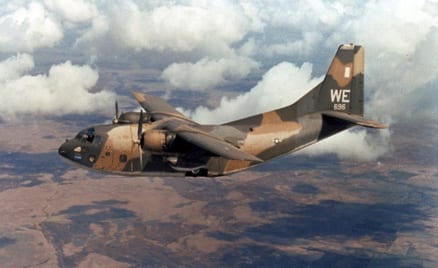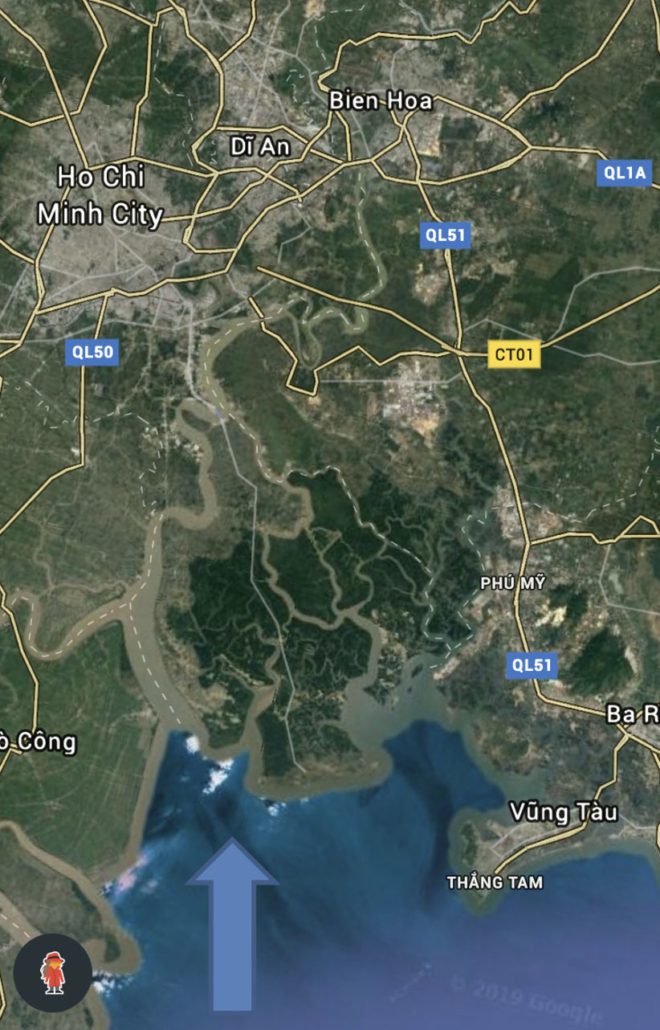Between early 1966 and early 1967, I flew in the 19th Air Commando Squadron in South Vietnam. The flying was absolutely the best experience I have ever had flying anywhere. Primarily the reason was that we had no restrictive rules to go by, we had few instrument procedures that we could follow, and the aircraft (Fairchild C-123 without jets) was ideal for the flying that we were doing. When I and everyone else who joined the squadron participated in the orientation flights to prepare us to be productive crewmembers “in country,” we were shocked and sometimes terrified at some of the maneuvering and procedures necessary to complete the missions. It wasn’t too long until we started relaxing and understood that this was the “normal” for accomplishing the missions that we had.
Flying IFR, we had few instrument procedures, so we had to improvise most of the approaches. This led to some quite interesting approaches as you can imagine. For instance, going into Saigon when the weather was bad, if you called Approach for an instrument approach, you would be given probably 45 minutes to an hour and a half for an approach time. If that happened, we would set the radar altimeter to 200 or 100 feet depending on how bad the weather was. We would fly down over the South China Sea and let down until we broke out. If we didn’t break out, then we would go back and ask for an approach time.
If we broke out, we would head back towards Saigon. We would find the inlet of the bay at Saigon and fly north. There was a river that emptied in on the north side of the bay. We would fly up that river.
Now, of course, we were high enough that we could see there were several turns and loops that the river had.
But we would fly north until we found a creek coming in on the left.
We turned to the runway heading (250) over that creek and kept listening to the radio to see if someone had reported the outer marker. If they had reported over the outer marker, we would do a 360 at that time and allow them to pass overhead. Of course, we couldn’t see them, but the 360 maneuver would give them enough time to pass overhead. After that we would go back to the runway heading and call the tower and give our call sign of Provide 54. The call I made was, “ Saigon Tower, Provide 54 VFR final for landing.”
Usually the response would come back “Provide 54, Saigon Tower, cleared to land.” We would proceed to visual contact of the runway and go ahead and land. Saigon Tower knew the Provide call sign and what we were doing.
For takeoffs in IFR weather, we would file an abbreviated flight plan. They would give us taxi instructions, and when ready, clearance for takeoff. After takeoff we were cleared to contact Paris Control for departure. We would stay with Paris control until we were then handed off to one of the other controllers, or if we were in VFR conditions at that time, we would cancel our flight following.
One morning, the visibility was extremely bad. Operations knew that the field was closed, but our frag was a tactical emergency (TAC-E) mission. We started engines and tuned the radios to the ground controller and listened for a minute. The tower was transmitting for the VFR aircraft not to start engines or contact the tower until they put out the message that they were ready for traffic. They said the field was closed at this time, and for IFR aircraft not to start engines until they received their clearance.
I keyed the mic and transmitted, “Saigon Tower, Provide 54, TAC-E, taxi.”
Ground controller prime replied, “Provide 54, taxi runway 25.”
Now we had a problem, because getting to runway 25 was going to be difficult. As I pulled out of the parking slot, I did see a taxiway light. As I passed that light, I looked ahead until I could see the next light. That’s the way I got to the end of the taxiway in the run-up area. After run-up, we requested and were given permission to take off. I taxied on to the runway and stayed close to the left side so I could see the lights. As I passed one light on takeoff roll, I would look for the next light and so on until liftoff.
We would stay with Paris Control until VFR on top or were passed off to the next sector controller.
- Challenges in Vietnam - July 8, 2024
- Drop missions: aerial delivery - March 25, 2024
- Challenging runway flying the C-123 in Vietnam - January 15, 2024







Makes my hair stand on end! I taxied my OV-10 out at DaNang one morning when the weather was down around my socks, but tower wouldn’t release me on my IFR clearance. As I sat there, an Air America Porter pulled up and declared he was ready for his VFR takeoff and tower immediately cleared him for takeoff. Curious, I switched radios to listen to him as he got airborne to see what he did. As soon as he lifted off, he called departure and reported, “Air America 123, unable to remain VFR, request IFR pickup.” He was immediately picked up and went on his merry way. I quickly followed suit.
Thank you for replying with an interesting account of your experience.
Great story, Ralph!!! The s–t we did when we were young would never be allowed today but when you are involved in a war you do stuff you would never dream you could do!!!
That was some pretty awesome flying and you never mentioned the fact you were a big fat flying target for every VC with a gun!!!
I appreciate your comments. You are correct, we did some necessary acts to accomplish the mission.
Have you read my other submissions? If not, click on my name and Air Facts will display them.
Wow! Improvised IFR, indeed! As a shiny, new C-130 flight engineer in the late 70s, I was trained by and flew with pilots and FEs who had flown tac airlift in-country. Similar stories about the men and machines of that time helped me put a lot of things in perspective.
Thanks for the input and your service an extremely important crew member.
Have you read my other submissions? If not, click on my name and Air Facts will display them.
Ralph, I would love to read more of your stuff, but while clicking on your name brings up the first sentences of the article, there is no link to read the whole thing.
I tried clicking on the title and there is something wrong with the program. Go to the SEARCH and put in the first part of the title. That should work.
Gets better every year you tell it. ;-) We had to do it in formation in the A4 and didn’thave ILS. Stay well and best, Vince
Thank you for your comment. I too have formation jet actual instrument time. I enjoyed every minute of it.
Enjoyed this memory of yours. Vietnam made many a boy become a man. The maps used helped visualize the flight path, and your details came alive. FWIW, I’ve written 3 articles for Air Facts Journal. One was of my first memories of aircraft activities on our farm grass strip that includes stories of aircraft doing things they were NOT designed to do. Another is of my mistakes in my early hours of flying, and the last is of memories of my 18,000hr CFI, corporate pilot brother from solo to 13 months in Alaska doing some part time flights while serving in the Army, to the corporate flight department world. Now gone since cancer took him in 2014, my early memories of him from the farm to teaching me to fly remain solidly in my soul. I saved to myself on email a link to your other articles, and plan to immerse myself in those further memories of yours soon. Thank you for sharing, and for your service!!
Thanks for commenting. I’ll look up your articles. Have you read all of my articles?
Haven’t read all your articles yet, but on my agenda.
I read and enjoyed your articles. Keep writing and submitting.
Very interesting article. Pic of the 123 immediately got my attention. I was a crew chief on the 123-K model, with 19th ACS at Tan Son Nhut from May ‘67 through May ‘68. Was there during Tet and was working the flight line that night. During my tour, I made many flights with great crews, some from Thailand. Some of those flights were at night that would raise the hair in the back of your neck. One night, while flying into a strip in the Delta south of Saigon, we had a new pilot from the states who was making his first night flight. We had flame suppressors on the exhaust to keep our visual signature down and all lights out of course. He had to make a go around after missing the approach. Unfortunately, he left the landing lights on. Yes boys and girls, you can see tracers coming at you! I jumped up on a palette to protect myself. After getting down, we had everyone running out to see if we were ok. Fortunately, we had no damage or injuries!
The 123 was a very good, strong bird that could take a lot of abuse. She wasn’t pretty and loved as the 130 but she got into areas that the 130 couldn’t. Thanks for bringing back the memories!
I was in the 19th ACS but left in Feb 67. Thanks, also, for the episode that you wrote about. Have you read my other articles articles in Air Facts?